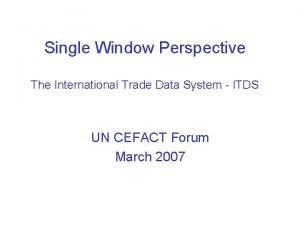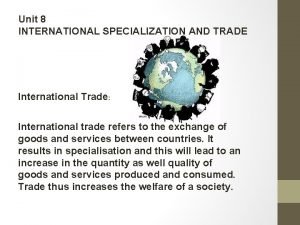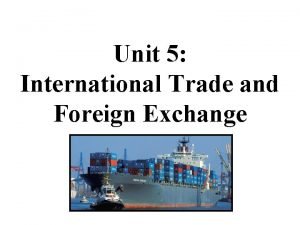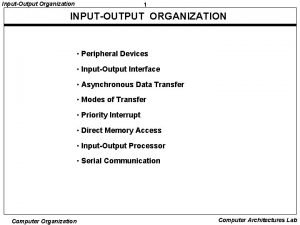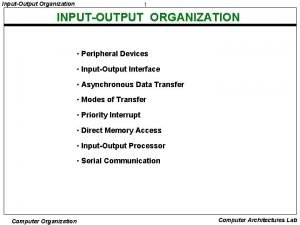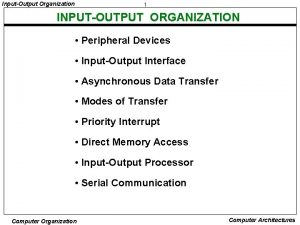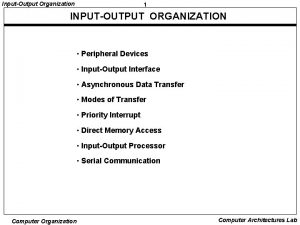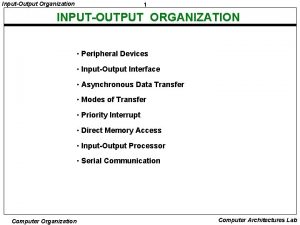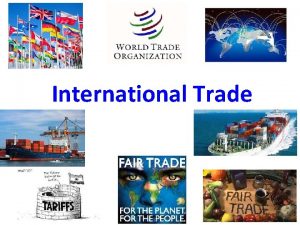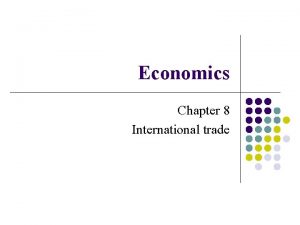Harmonising international trade data for intercountry inputoutput analysis













- Slides: 13

Harmonising international trade data for intercountry input-output analysis: statistical issues Dong GUO, Norihiko YAMANO and Colin WEBB September 22 nd , 2008 WPGTS, Paris

Background • Economic globalization: the significant trade in intermediate goods and services globally • More fragmented production process across countries • Inter-regional input-output model: tools for wide range of global analyses

Trade data and IO analysis • Input-Output tables by OECD – Separated the domestic transaction from the imported transaction – Harmonised for 40 countries • Multi-Regional IO – Trade structure integrated into IO analysis – Interregional feedback effects • Challenges – Optimal data for trade structure between countries required (goods and services)

Linking trade data with IO Country B Country A Sector 1 IMD FD Sector 2 Sector 1 Sector 2 CP IP Country C Sector 1 Sector 2 IMD FD CP IP Country A Sector 1 Sector 2 IO Sector 1 = Country B + Country C Sector 2 = Country B + Country C

Trade in goods – Data issues • Re-exports – Trade discrepancies: Classic case = China /HK/USA • Un-allocated trade data – Possibly concentrated in certain industries and partners • Trade in second-handed goods – Not linked to recent manufacturing production • Scrap and waste products – Some identified by HS, others not (e. g. PCs) • Trade by industry classifications – OECD IO: by industry; trade statistics: by products

China-US: trade discrepancies (official statistics, billion USD) Chinese US Chinese imports exports from the from to the US US China (Chinese (US data) Data) data) US- China trade balance (US data) USChina trade balanc e (Chine se data) Year US exports to China (US data) 1995 11. 7 16. 1 45. 6 24. 7 -33. 8 -8. 6 2002 22. 1 27. 2 125. 2 70. 0 -103. 1 -42. 8 Source: Fung and Lau (2003) Table 1

Unallocated trade (% total trade) Exports Imports 1990 1995 2000 Australia 14. 4 15. 9 19. 1 3. 6 2. 3 2. 1 Germany 1. 6 3. 6 2. 3 2. 1 5. 5 5. 2 Ireland 4. 4 6. 9 4. 3 2. 9 9. 2 5. 8 Norway 5. 6 7. 3 4. 4 0. 8 0. 9 1. 0 USA 3. 9 3. 3 3. 5 3. 4 4. 4 Russia - - 12. 3 - - 13. 2 South Africa - - 24. 7 - - 8. 8

Trade in services / BOP • Improvement in recent years with available data allows improved MRIO modelling • Conceptual differences between EBOPS and Industry classification • Particular issues – Goods sent abroad for processing – Merchanting

Differences in published trade statistics • Merchandise trade statistics – ITCS v. COMTRADE: notably pre-2000 data; subtle differences after ‘synchronization’. • Service trade statistics – Between OECD TIS and UNSITS • Exports of manufactured goods – Between OECD BTD and I-O datasets

ITCS data as % of COMTRADE data, Germany, 2006 Exports Total Commodities not specified according to kind 63: Other textile articles; clothing etc 73: Articles of iron or steel. 82: Tools and implements of base metal 84: Machinery and mechanical appliances and parts; boilers etc. 85: Electrical machinery and equipment and parts thereof 87: Vehicles other than railway or tramway rolling-stock; parts 88: Aircraft, spacecraft, and parts thereof. Sum of all other 2 -digit HS commodities Imports 100. 0 66. 2 102. 2 101. 4 103. 1 100. 0 86. 8 100. 0 100. 9 101. 5 100. 1 100. 8 100. 0 104. 7 105. 7 100. 0 105. 2 106. 0 100. 0

Possible solutions • short-term – Re-exports: more information from countries, particularly for key I-O years (1995, 2000). – Un-allocated trade: more information on composition. • longer-term – Systematic reporting of re-exports – New products codes to identify scrap, waste, recycled goods etc. – Reporting of BOP trade in goods by product groups

Summary • More to international trade statistics than meets the eye • Attempt at guide for researchers with limited experience of using trade statistics • Highlights issues to be considered when using trade statistics – particularly for I-O related analyses

Thank you !
 Rotary intercountry committees
Rotary intercountry committees Inputoutput devices
Inputoutput devices International trade data system
International trade data system Trade diversion and trade creation
Trade diversion and trade creation Umich
Umich Trade diversion and trade creation
Trade diversion and trade creation The trade in the trade-to-gdp ratio
The trade in the trade-to-gdp ratio Fair trade not free trade
Fair trade not free trade Trade diversion and trade creation
Trade diversion and trade creation Tramp and liner shipping
Tramp and liner shipping Ted talk atlantic slave trade
Ted talk atlantic slave trade Mercantilism theory of international trade
Mercantilism theory of international trade Specialization in international trade
Specialization in international trade International trade and foreign exchange
International trade and foreign exchange


